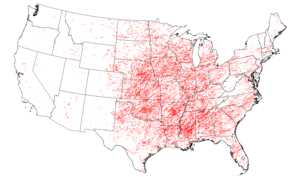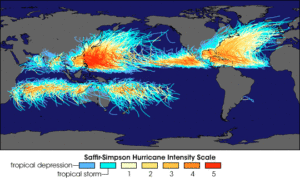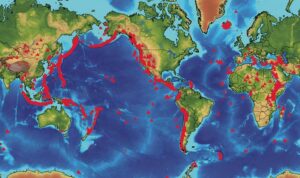Safest Places to be when SHTF
To find the safest places in the lower 48, we need to look at some historical data. Weather charts such as tornado path history, hail, flooding, and tropical system history can help us avoid some chaos. Other factors may include wildfire data, earthquake fault lines, volcanic activity, and locations of missile defense systems. Knowing the likelihood of natural and human-caused disasters will help determine the best locations for survival.
Highly populated areas on the coast (in my opinion) are the least safe places to be. City’s on the coast are in harm’s way from natural disasters such as hurricanes, earthquakes, volcanos, and tsunamis. In addition to natural disasters, major populations are hard to get out of in times of crisis.
In the event of an attack, major cities are going to be targeted first. Either directly like a bomb or bioterrorism. Or indirectly, by cutting off food and water supplies or destroying the escape routes.
Safest Places from Natural Disasters
In this map of tornado path history, it is clear that most activity is east of the rocky mountains. Storms large enough to produce tornadoes can also bring chaos in the form of severe weather such as lightning, flooding, hail, power outages, and strong winds. 

This illustration shows hurricane and typhoon paths. The east coast of the U.S. and the gulf coast are bullseyes for these powerful storms. But the east coast of China and nearby countries suffer more intense systems, according to historical data. 
The volcanic activity is shown in red around the Pacific Ocean. As well as a few other hot spots around the world. The biggest threat to the lower 48 is Yellowstone. If this supervolcano were to erupt, the fallout would be catastrophic. The safest place to be would be west and southwest. Hawaii is a volcanic island in the middle of the ocean. It is surrounded by a ring of earthquake and volcanic activity. A beautiful vacation destination, but not a safe location. 
Earthquake activity follows similar lines to volcanoes. The exception is large mountain ranges not created by volcanoes.
Human-caused Disasters
Unlike the weather, human-caused disasters worry me the most. Just the thought that my family’s safety is at the mercy of another human pisses me off. Unfortunately, this is reality and we must prepare for all threats.
I started taking prepping seriously around ten years ago. I found a book called Strategic Relocation authored by Joel M Skousen and Andrew Skousen. In this book, I discovered a very well-thought-out way to plan for CHAOS. Many of the illustrations used in this blog post are from the book. I will leave an affiliate link at the bottom of this page if you want a copy for yourself.
There are many targets an enemy would consider valuable when planning an attack. Such as highly populated cities, roads, bridges, supply lines, and nuclear weapon caches, to name a few. 
After endless hours of research. Each state has been given a rating. 5 stars being the safest and 0 being the worst. For the purpose of this post, I will share the best and the worst. Along with the reasoning behind the ratings. Keep in mind that states are evaluated as a whole, so if a state is rated as 3 or 4 stars, that doesn’t mean you can’t find a safe place within that state.

The Best and the Worst Safest Places
According to this map, there are two 5-star states and four states with zero stars. Florida is my pick for the worst place to be when SHTF. It is a great vacation destination, but it is surrounded by coastline. Hurricanes can hit from all directions. Tornadoes from tropical systems are common. There is a high population density and traffic sucks. Crime rates are among the highest in the nation. There are 10 military targets and 3 nuclear power plants. The growing season is long for citrus crops, but the soil lacks proper nutrients for many other crops. This is a result of the sand. Florida is a sand bar and not entirely stable. Sinkholes are also a common problem there. I am not a fan of humidity either.
Idaho is my top pick for the safest place to be. The book has Utah and Idaho tied at 5 stars, but I can’t entirely agree. There are counties in northern Idaho that only require septic and electrical permits, but do not require building permits. There is a low population and traffic is not a problem. This is a dry climate and most crops are possible below 5500 feet. Crimes rates are low. There are only 3 military targets. Severe weather is uncommon in this area. Natural resources are abundant, as over 60% of the state is federal or state land. It can get cold in Idaho, but major winter storms such as blizzards are also uncommon.
In conclusion
With the help of this wonderful book, “Strategic Relocation” you can find the best location for safety nearest to you. I don’t live in Idaho, but by looking at all the information available I have discovered the best location in my state. For now, it is just a bug-out destination. I would love to live there someday, but some things would have to fall into place for that to happen.
Note, I am an Amazon affiliate and I earn a small commission on qualified purchases. Thank you for your support.
